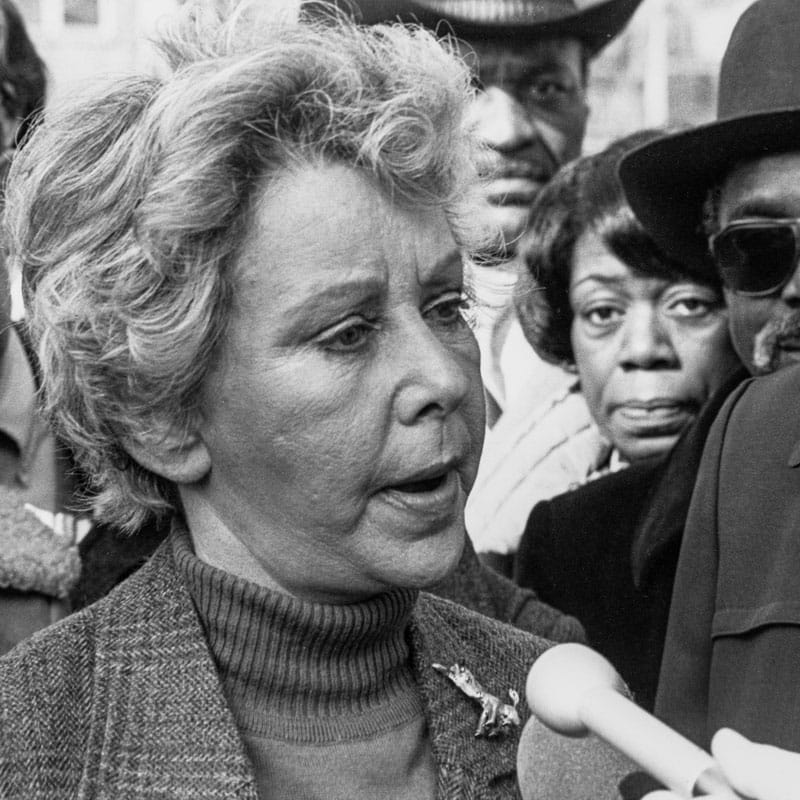
Meet Jane Byrne, Chicago’s First Female Mayor
Published on March 23, 2023
In honor of Women’s History Month, we’re pleased to feature Jane Byrne, who served as Chicago’s 50th mayor from 1979-1983.
By Dave Lifton (@daveeatschicago)
From 1837 until 1979, 49 men had served as the mayor of Chicago. Then came Jane Byrne, who broke through the glass ceiling that led her to the fifth floor of City Hall.
Jane Byrne was born Margaret Jane Burke on May 24, 1933 and raised in the Sauganash neighborhood on the Northwest Side. A year after graduating Barat College of the Sacred Heart, she married Lt. William Byrne, a Marine pilot. A daughter, Kathy, arrived in 1957, but tragedy soon struck. On May 31, 1959, William was killed when he attempted to land his plane at Glenview Naval Air Station in a dense fog.
Byrne’s mother suggested that she work at the local office for Sen. John F. Kennedy’s presidential campaign. The job put her in the orbit of Mayor Richard J. Daley, who saw potential in Byrne. On his suggestion, she volunteered for her alderman, and, by 1964, she had a job in Chicago’s Head Start program, and was soon promoted to the Chicago Committee on Urban Opportunity.
Byrne became the first woman in Daley’s cabinet when, in 1968, she became Commissioner of the city’s consumer protection agency. Byrne’s diligence caused her to run afoul of the rank-and-file in City Hall, but Daley protected his protégée. Seven years later, Daley appointed her co-chair of the Cook County Democratic Central Committee.
Daley died in 1976 and Michael Bilandic was named interim mayor. Byrne’s career soon took a fateful turn when she publicly called out a proposed 12 percent increase in taxicab fares, saying it was the result of cronyism. Bilandic fired her from both jobs in early 1977.
Byrne’s response was to run for mayor. She campaigned against the system, even calling out two aldermen, Ed Vrdolyak and Ed Burke, as being the leaders of an “evil cabal.” She earned the support of the Black community, but Bilandic was still ahead in the polls. Then came the winter.
In the first two weeks of 1979, approximately three feet of snow fell on Chicago. The city’s poor response, particularly in Black neighborhoods, reflected badly on Bilandic. With the Democratic primary only six weeks away, Byrne seized on the opportunity, running ads that portrayed him as incompetent and out of touch.
On Feb. 27, Byrne stunned Chicago by carrying 29 of 50 wards and barely defeated Bilandic. The general election was a formality, with Byrne winning 82 percent of the vote—still a city record—over Wallace D. Johnson.

Once in office, Byrne’s attempts to cut city spending led to strikes by transit workers, teachers, and firefighters in quick succession. She upset the Black and progressive communities, both through her appointments and by making the peace with Vrdolyak and Burke, which was seen as a betrayal of her campaign promises. Her decision to move into the Cabrini-Green housing projects for three weeks in 1981 was seen as an ill-advised publicity stunt.
There were highlights, however. Byrne authorized the extension of the West-Northwest Line (now Blue Line) to O’Hare International Airport and the creation of the Orange Line. She proposed a handgun ban that passed in 1982 and remained in effect until the Supreme Court struck it down in 2010.
Her greatest and most lasting successes came in cultural affairs. Byrne increased funding for the arts and brought Hollywood to Chicago. She created Taste of Chicago in 1980, threw the city’s first official Gay Pride Parade in 1981, cleaned up Navy Pier, and began the process to create the Museum Campus.
But those victories weren’t enough to earn her a second term. In the primary, she faced challenges from Richard M. Daley—her mentor’s son—and Harold Washington, who ran, as Byrne did four years earlier, as an anti-establishment candidate. Byrne finished second to Washington, who went on to become Chicago’s first Black mayor.
Byrne made two other efforts to run for mayor, in 1987 and 1991, but lost in the primaries on both occasions and subsequently retreated from public life.
In the summer of 2014, the park on which Chicago’s iconic Water Tower sits was named Jane M. Byrne Plaza. A month later, the junction of I-90/94, I-290, and Ida B. Wells Dr. was renamed the Jane Byrne Interchange. Byrne died on Nov. 14, 2014 from complications of a stroke she suffered nearly two years earlier. She was 81.
Jane Byrne overcame sexism, entrenchment, and a city in chaos to make tough choices, even if they ultimately ended her career. Her legacy should be seen as one of a trailblazer for generations of female politicians.

The Adventure starts when you say it does.
All eATLAS Adventures are designed and built by experienced eATLAS Whoa!Guides. They're always on. Always entertaining. And always ready to go.
Check out our Adventures!